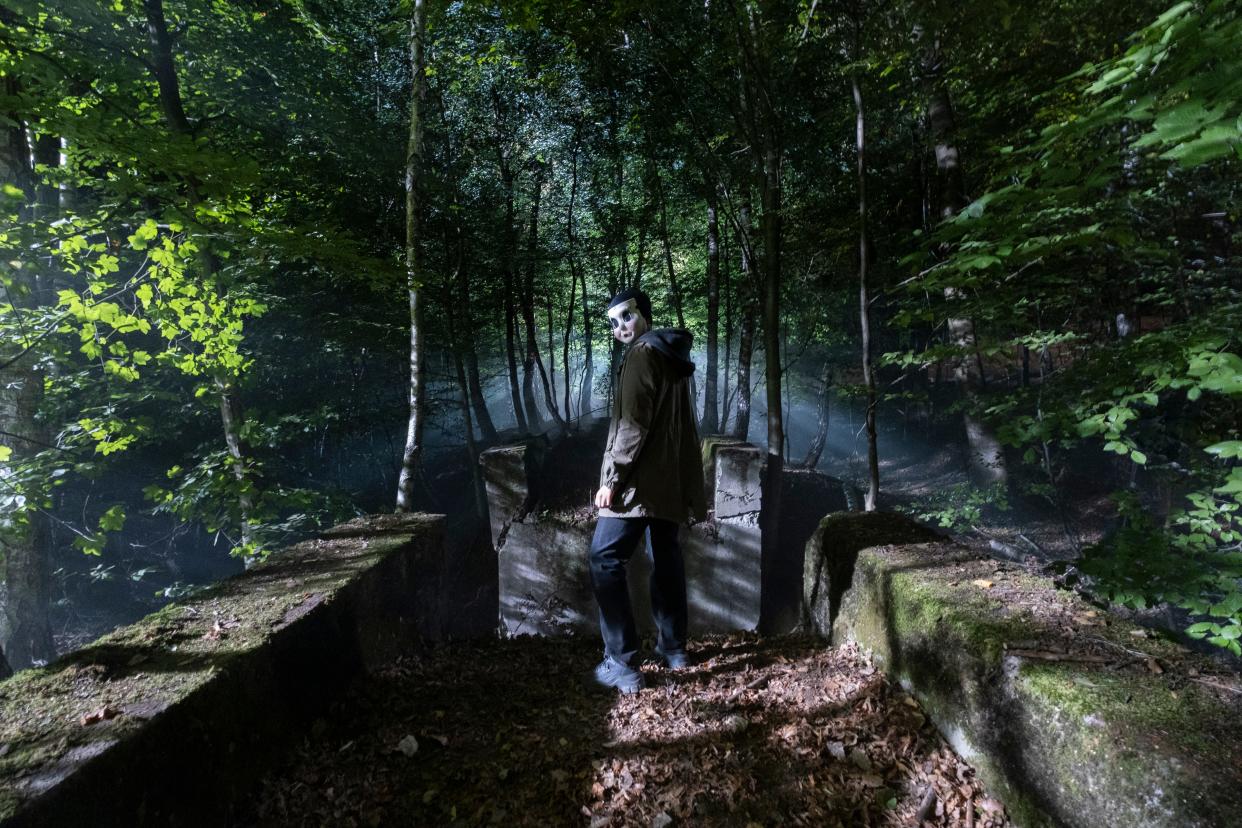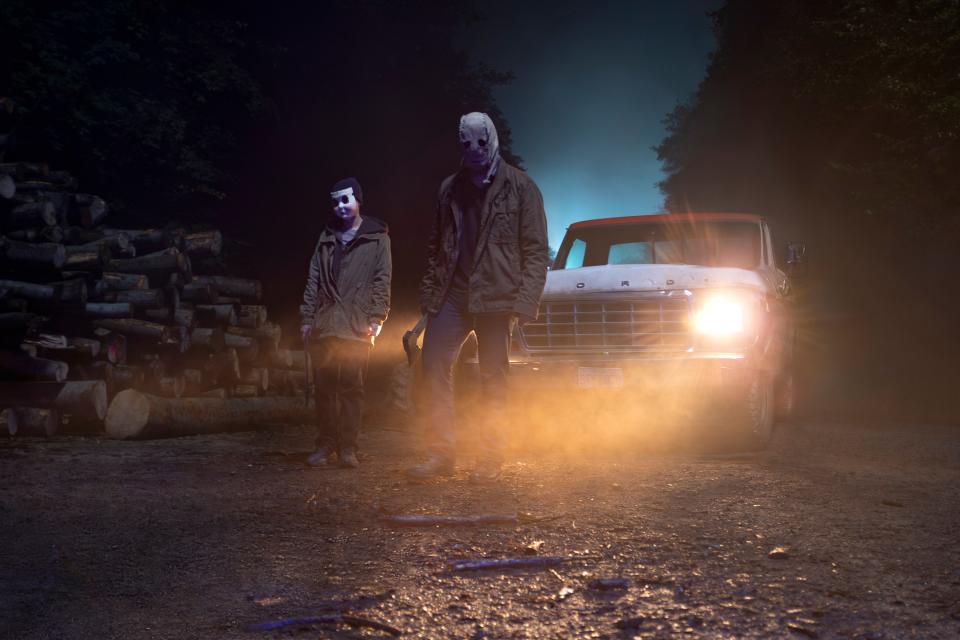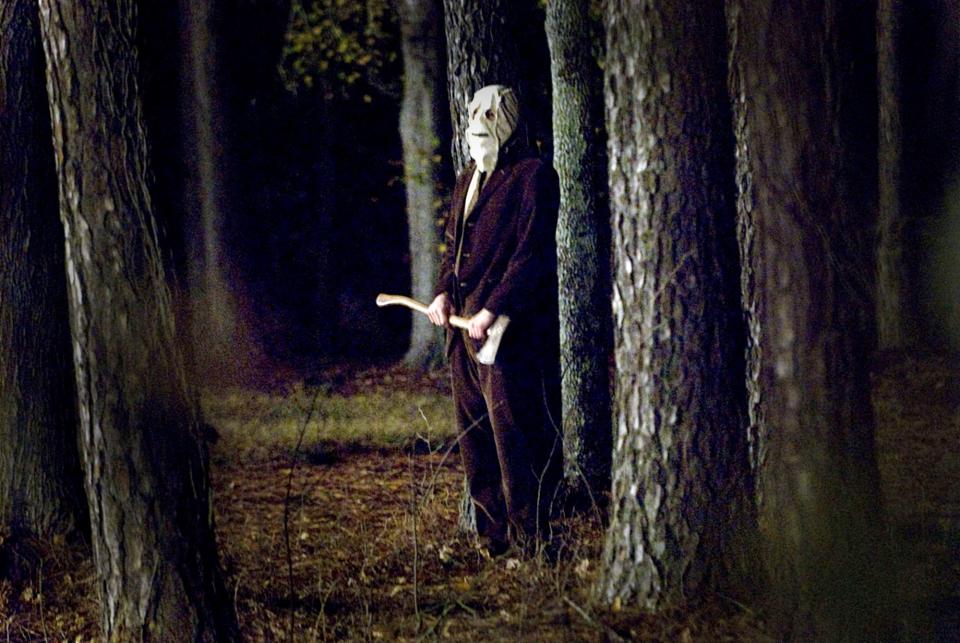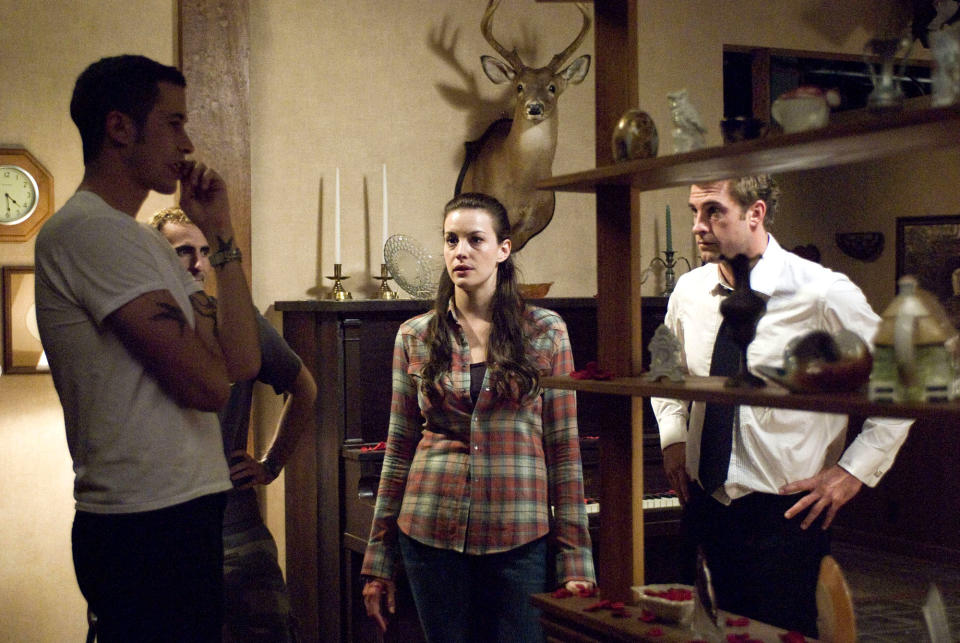Why The Strangers Still Scares Us

John Armour/Courtesy of Lionsgate
Horror fans are accustomed to every little splatter, stabbing spree, or haunting inspiring sequels, no matter how little inspiration seemed to be there in the first place. They’re also used to picking up on whatever faint glimmers of quality are visible through the direct-to-video muck. (Did you know that Wrong Turn, the 2003 Texas Chain Saw Massacre knockoff starring Eliza Dushku, is actually a franchise with seven entries? And that depending on how hardcore the horror fan in your life is, they may have a favorite that’s not just the one that came out in theaters 21 years ago?) This makes it all the more unusual that The Strangers, Bryan Bertino’s home-invasion slasher, could make so much money in 2008 without immediately inspiring a whole series. Instead, a single follow-up—The Strangers: Prey at Night, best known to horror geeks as the movie surrounding an impressive neon-lit swimming-pool scene– arrived almost a full decade later from an indie studio. It did OK business, and this not-exactly-a-franchise series went quiet again. Until now— because, in horror, there’s always an “...until now.”
So how and why is it that 2024 will see the beginning of a whole new Strangers trilogy? And not just the beginning, either; although The Strangers: Chapter 1 is the one with a plum summer-movie release date, it won’t need to beat Garfield or Mad Max at the box office to assure the existence of Chapter 2. That movie is already done, and will release sometime this fall. Director Renny Harlin is still finishing up The Strangers: Chapter 3 for release in early 2025, but all three films completed principal photography in a single 55-day shoot, so there’s no question that all three of them will emerge in the next nine months or so. There is about to be a 150% increase in the number of extant Strangers movies. Even a horror fan could be forgiven for asking: Why now, though?

strangers body img
John Armour/Courtesy of LionsgateOn one hand, the franchise machine comes for everyone and everything eventually. On the other, it’s not as if horror sequels didn’t exist in 2008, when The Strangers made its money. Something beyond the brand name must have drawn people back into this unsettling world where a couple (or, in Prey at Night, a family) is menaced at a semi-desolate but not overtly threatening location by a trio of silent, masked assailants, who notably lack backstory, slasher superpowers, or motivation. That last one feels most explicitly absent in the original; in the first film’s climax, which is also maybe its most famous moment, the strangers have captured Liv Tyler and Scott Speedman, who ask them why they’re doing all this. The killer trio’s designated speaker— she’s the one who kicks things off by knocking on their door and asking for “Tamara” before disappearing into the shadows— offers a concisely creepy answer: “Because you were home.”
Still, that doesn’t fully explain why this movie is now considered major franchise fodder. (The previous sequel took a full decade to come out.) My theory is that The Strangers is the kind of horror movie that rattles around in your head after seeing it, and maybe pops back into it the next time you hear the unmistakable but still shakable sounds of humans existing in your vicinity – unexpected knocks, footsteps, or voices. Almost all the time, this is just normal life stuff. But sometimes, as the shameless opening text of both the original film and Chapter 1 implies, it is an unknown violent criminal in the mood to murder a stranger.
But there’s no need to depend on my horror-fan analysis of why a minimalist slasher with relatively little actual slashing and no ostentatious personas might still become a horror franchise. GQ spoke to both Renny Harlin, the director of the new trilogy, and Bryan Bertino, the writer-director behind the original, as well as the star of the new movie, about the enduring appeal of The Strangers.
Harlin says that he saw his job as “replicating the experience” of The Strangers without copying it – and he’s no stranger to the world of existing horror series. The Finnish filmmaker’s first American feature was A Nightmare on Elm Street 4: The Dream Master; he also directed an Exorcist prequel when writer-director Paul Schrader’s version was deemed too artsy for mainstream audiences (eventually both were released). Outside the horror world, Harlin also made Die Hard 2: Die Harder. “What I’ve learned from my previous experiences when I go into an existing franchise,” he says, “is that it’s really crucial to honor the original material and do your best to give the fans what they would expect.”

strangers archival 2
Everett CollectionPretty much what any professional filmmaker has to say in this situation, granted, but Harlin, a stylist whose ’90s slickness now seems almost classical, is specifically a fan of The Strangers: “I remember I saw it in L.A. in a movie theater, and didn’t really know anything about it except that it was a horror film and it looked interesting. I remember being so shocked and impressed by the fact that you could do a movie where there’s no rhyme or reason to what happens. We’re so accustomed to there always being a payoff and a neat explanation in the end, no matter what the genre is. That kind of random violence happens a lot, but in the movies we’re not used to it. I remember that experience very vividly. It was a brilliant breath of fresh air. I wouldn’t have taken this task if I wasn’t a big fan of the original Strangers movie. I felt intimidated to a certain degree, diving into this.”
Harlin also cites feeling intimidated as a possible reason that he didn’t contact Bertino, the original writer-director, before making this new version – though Bertino’s choices on the original did inform Harlin’s on the new movies. (He also has a story credit on it, presumably because Chapter 1, at least, hews pretty closely to the structure of the original film.) In the 2008 version, Bertino intentionally sticks to the ground level. Chatting via Zoom—he’s in mid-production on his horror film Vicious, out next year— Bertino notes that The Strangers was designed to stay small. Some of this was for practical purposes: “I wrote it kind of thinking about it as, can I make a movie for fifty grand with a couple of friends?”
Even after the movie was sold to Universal, however, and Bertino was eventually hired to direct as well as write, he kept it simple. “Seven is one of my all-time favorite movies,” he explains by way of citing a more complex movie about a mysterious killer, which in turn seemed to inspire the Saw movies that were so popular at the time of The Strangers. “But there were elements of it that just felt so big, and so stripping it down, and wanting to take a more punk-rock kind of vibe, I thought was in some way [trying to] get back to something very simple. You watch [The Strangers], there are no giant tracking shots, there’s no crane, the camera is just down with the actors. That’s why I think it seems to resonate with people: They put themselves in that space.” Harlin noticed this as well. “My first decision was that I have to stay away from [hand-held camerawork],” he says. “It worked great in the original, but if you copied that, it would be like copying everything.”
Another major part of the 2008 film is less tangible than its stylistic choices: It has the slightly disreputable, insinuating feel of something that claims to be inspired by a true story, but can’t quite pinpoint what true story it’s talking about, rendering it half folktale and half carnival barking. Its canny mixture of seriousness and exploitation worked its magic on Madelaine Petsch, Riverdale’s Cheryl Blossom, who stars in the new trilogy, who’s such a fan of the original that a 290-page screenplay for a new version dropping in her inbox initially offended and impressed her in equal measure.
“I think people will probably think I’m lying because I’m in the [new] film,” Petsch says, “but I’ve probably seen the original Strangers, conservatively, 30 times in my life. Every time I’m alone, it’s the thing I turn on; it’s one of my favorites.” She elaborates with a classic horror-fan origin story: “I was 14 years old, I went to Blockbuster with my dad. My parents were going on a date night that night. I was kind of chipping my way through the horror section around that time, and my dad had heard of this film, and I was like, I want this one. He was like, I don’t think you should watch this alone, [but] he got it for me anyway. So I watched it alone at 14 years old, like a true psycho, and when my parents came back, I was absolutely fucking terrified. What resonated with me, and I imagine a lot of people had the same experience, was that it feels real.”
Though the movie itself doesn’t get specific about what true story has inspired it, Bertino does, attributing the movie’s genesis to a mix of his fascination with the Manson murders and a specific, less brutal incident from his childhood. “I grew up on a street that was kind of in the middle of nowhere. Once my parents were gone, and my sister and I were left alone, and someone knocked on our door. My sister answered and said my parents are in the shower or whatever, and they left. We found out the next day that people had come and gone from house to house knocking on doors, and if someone didn’t open the door, they broke in. So I started thinking about what if you knocked on doors, and whoever answered, you killed. The randomness was really terrifying to me – the idea that you didn’t commit some sin that caused you to deserve suffering. You didn’t have a house on an Indian burial ground or hit somebody with a car…”

Strangers archival
This aspect of The Strangers set it apart from other, more series-friendly 2000s horror properties that focused heavily on the “why?” of extreme bodily cruelty. The Saw movies were (and, in their recent revival, continue to be) based on some warped version of a moral code, while the similarly torture-heavy Hostel and its sequel offer a flipside where the perpetrators of torture do so to exercise and test the flexibility (or existence) of their own personal just-for-kicks morality. Petsch also has an affinity for the Saw series; she’s planning a break from horror acting now that she’s done a full trilogy, but she reports geeking out with Lionsgate staffers (“What’s Saw XI going to be? Is Tobin Bell going to be in it?!”)
The Strangers doesn't quite belong with those movies; it’s far less gory, and its masked strangers seem to have more in common with the lore-heavier Purge series, which emerged five years later. For that matter, no one in the movie is as magnetic or interesting as Tobin Bell’s Jigsaw, despite that character being two years dead when The Strangers came out.
But the actual feeling of watching both The Strangers and its 2018 sequel might be more akin to torture than actual so-called torture porn, given that the victims are ultimately toyed with; they’re constantly forced on the defensive, rather than turning the tables for a satisfying final-girl assault. Even Prey at Night, which is a little more satisfying in this regard, makes any victories as beholden to blind luck as the initial victimization. Rewatching the first film, I found that my memory of it was so downbeat that I had forgotten how it actually ends: With Liv Tyler waking up and screaming, not dead. She’s been stabbed pretty bad, and may not actually survive, but the movie leaves her bleeding, not definitively offed.
In that way, The Strangers draws a line between the identification of torture-centric slashers and the less gory bleakness often seen in found-footage horror. (The delayed release of Paranormal Activity would revive that horror subgenre in 2009, a year and change after The Strangers.) It wasn’t necessarily a conscious decision from Bertino, writing toward a workable budget, but it’s compatible with his particular vision of horror.
“When you picture the scariest moment in your life,” he says, like waking up and finding someone inside your house, “you don’t think about the happy ending you’re going to have, like, I can’t wait to win! You’re scared of ‘what happens if I don’t?’ So it always made sense to me that in horror movies, the end result can’t always be victorious. Sometimes that’s the most terrifying. I think that’s part of what made found-footage resonate with people. Texas Chain Saw Massacre was an inspiration, because whether Liv Tyler lives or dies, she doesn’t feel like she won. She’s like the woman at the truck at the end of Chain Saw, just screaming.”
That Tobe Hooper classic was sequelized and remade, too, rarely to good effect, apart from the fascinatingly bonkers sequel Hooper himself agreed to direct more than a decade later. The new Strangers trilogy is promising something bold through its serialization, though to avoid positioning it as a sequel to the 2008 or 2018 films, Chapter 1 must go through the motions of retelling an updated version of the story, deferring any bigger twists for later on. In classic horror fashion, it ends by teasing a sequel that horror fans will almost certainly want to see. Harlin reveals that the three movies take place over the course of about five days, suggesting something not unlike the pairing of the original Halloween and Halloween II (which Bertino, coincidentally, cites as an underrated fave).
For his part, Bertino hasn’t seen the new film yet. “I was gonna go to the premiere, but I’m still here [shooting Vicious]. But I’m supportive of it— I like the idea of building this trilogy. 15-year-old me would have been pretty amazed that I’m involved with something that would now have like five films and that has created a life of its own.” He also appreciates that the new trilogy promises to keep the titular Strangers human, showing that “you don’t have to have them be the devil or Freddy Krueger” to get the audience scared.

strangers petsch
It sounds simple, but the flirtation with nihilism can scare producers, too. Bertino recounts the first movie's long road to the screen, even after the script got him an agent and a manager: “I got fired, and they rewrote it, and rewrote it again, trying to put it in the box studios were used to at the time. It was only a year and a half later that they changed it so much that they couldn’t figure out why it wasn’t good anymore. They robbed it of what it was. When I came back and directed it, even then the studio didn’t know what they wanted to do, so it sat on a shelf for about a year, and was gonna go to DVD before they changed their mind at the last minute. And it was really because at the time, you just didn’t make horror films that felt like that. You kind of wind up with horror films that feel more like action films. I think there’s a lot of different types of horror films that can’t exist. But I don’t make wish-fulfillment horror films.”
Is Vicious, starring Dakota Fanning, in that same vein? Bertino describes it as “intimate,” saying that Fanning’s character finds herself in an overnight ordeal where “her whole world is torn apart, and she’s forced to scramble to hold on. I think it’s certainly in my ballpark – if anything, I’m getting darker as I get older. Putting Vicious in the title, you have no doubt what you’re getting into.”
It sounds like a new approach to Bertino’s basic idea for The Strangers, one not so removed from the likes of Halloween or Texas Chain Saw: “If you actually built a connection with the audience and put them in the space, they would actually be more frightened than if you took them and put them in some special world.” In this context, an idea as loopy as a single-year Strangers remake-plus-sequels trilogy makes a little more sense: It’s a way of keeping a horror audience that’s become accustomed to back-from-the-dead revivals and constant legacy sequels in that single space a little longer.
Originally Appeared on GQ


